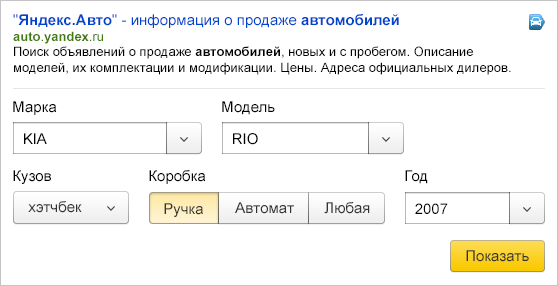Yandex “Islands”: technical side and API
On May 16, at the YaC / m conference, Yandex announced the launch of a new search platform “Islands”. Already in the first two weeks after the announcement, webmasters created about 1000 islands for their sites. But the new platform raises many questions. We already told on Habré about how the Islands look and why they are visually arranged in this way.
My name is Oleg Levchuk, I work as a manager in the “Islands” team and am responsible for interactive answers in Yandex search results. So today I want to talk more about how interactive answers work and on what principles they are based. Let's start with how this idea appeared - it will help you to better understand the result.

')
Yandex has consistently developed the presentation of search results. On the one hand, we worked with the results of the "organic" issue, on the other hand, we did specialized answers, which we called witches.
The search results page consists of 10 links with short annotations - "snippet". If earlier they included simple text comments, then over time, elements began to appear in them that helped a person to assess the relevance of the site: address, phone number and organization time, links to popular sections of the site, pages on social networks, etc. This is what a modern snippet looks like:


The next evolutionary step is separate solutions for different topics. Using micromarking and affiliate programs, Yandex began to extract additional information from the site page and create an extended snippet for it. For example, for the subject of "recipes", the search shows step-by-step photo instructions, and for reviews on cars - headings and the beginning of the text.


In 2000, when a parallel search began to be carried out on the news feed and the database of goods from online stores, a new answer form appeared on the search results page - koldunshchiki. Yandex services because only they had such a technical opportunity, they began to use it in order to present their functionality in the search.
To solve simple problems, we develop small special services that exist only on the search results page. For example, a currency converter, solving square equations, or a schedule for turning off hot water.


For more complex tasks, vertical services have appeared that complement the “universal” search in specific areas. For example, Yandex.Market allows you to select a product and determine the best price for it in online stores, and Yandex.Maps - to find the right address and build a route to it.

In order for services to better understand the user and solve his problem more quickly, we began to put their functionality into the search. For example, Yandeks.Pespisaniya learned to determine from a search query route points and put them in the search form of tickets.

As a result, such a rich interactive response reduces the number of actions that a person must perform, and, naturally, improves the presentation of the service itself.
The presentation of the organic issue did not have time for our experiments with the charters - there was no technical possibility to provide real-time data processing for all sites. But I wanted all sites to be presented in a similar way. So we came up with the idea of interactive answers for organic delivery - islands.
In the process of integrating Yandex services into the search, we realized the possibilities that webmasters need to provide to create interactive responses:
Based on these opportunities, the island can be divided into 3 types.
Informational. Visual representation of data from the site in search results, including in real time.

Search engines Forms for refining the request, buttons and other elements that prepare to search the site.

Transactional. The ability to perform an action directly in the search results or prepare for it before going to the site.

In the process of developing the “Islands” platform, we formulated for ourselves some principles that we will follow, despite possible changes in the interface and technology.
Opt-in
The concept of islands is based on voluntary participation. The site owners independently configure the display of their content on the search results page and control what will be put on it as an interactive response.
Traffic generation
The main task of interactive answers is to improve the presentation of sites in search results. Due to this, users will better understand which link to go to in order to get the necessary information or perform the necessary action, and site owners will receive an increase in conversion. Particularly useful islands should be in mobile search, where the need for a quick solution of a specific problem is much higher.
The transaction takes place completely on the search results page only in cases when it is beneficial not only to the user, but also to the webmaster. For example, when buying tickets or checking in for a flight.
Ranging
It is important to emphasize that interactive responses are an interface solution that will not affect the ranking in the near future.
But we said that the ranking takes into account many factors. Yandex analyzes the preferences and behavior of users depending on their requests. If users interact more with sites that have islands, this may be taken into account in the future.
To better present the ideas and possibilities of interactive responses, we have prepared a preliminary version of the specification. It will be supplemented in the process of collaboration with webmasters. If you think that something needs to be done differently, tell us about it.
Now we assume a form description language and API for real-time interaction.
To display the form in the island, you need to pass a list of fields and their values. Then Yandex will be able to parse search queries related to the site, and automatically enter values into the appropriate fields. If the user refines the request using drop-down lists, checkboxes, etc., he will immediately get to the page of the site that will meet the specified parameters.
The API for transferring real-time information is the second and more complex component of creating interactive responses. It can return real-time data for a specific page (for example, weather for today or airport board). As well as complement the work with the form, instantly showing the result that the user expects. For example, when changing parameters, respond with the number of objects found or partial previews.
- Full specification
- Documentation for describing the search form and testing in our editor
Currently, of all the features described in the specification, our editor only supports the transfer of the form description in a separate xml file and the creation of a search interactive response using it. The remaining features will be supported later.
Also, with the launch of the beta version of the new interface in Russia, we will start experimenting with the islands and show some of them to real users.
If you have more questions or suggestions about how the Islands will work, ask them in the comments. We will try to answer all the important ones or even consider them when planning the further development of the Islands.
My name is Oleg Levchuk, I work as a manager in the “Islands” team and am responsible for interactive answers in Yandex search results. So today I want to talk more about how interactive answers work and on what principles they are based. Let's start with how this idea appeared - it will help you to better understand the result.

')
From snippets to islands
Yandex has consistently developed the presentation of search results. On the one hand, we worked with the results of the "organic" issue, on the other hand, we did specialized answers, which we called witches.
The search results page consists of 10 links with short annotations - "snippet". If earlier they included simple text comments, then over time, elements began to appear in them that helped a person to assess the relevance of the site: address, phone number and organization time, links to popular sections of the site, pages on social networks, etc. This is what a modern snippet looks like:


The next evolutionary step is separate solutions for different topics. Using micromarking and affiliate programs, Yandex began to extract additional information from the site page and create an extended snippet for it. For example, for the subject of "recipes", the search shows step-by-step photo instructions, and for reviews on cars - headings and the beginning of the text.


In 2000, when a parallel search began to be carried out on the news feed and the database of goods from online stores, a new answer form appeared on the search results page - koldunshchiki. Yandex services because only they had such a technical opportunity, they began to use it in order to present their functionality in the search.
To solve simple problems, we develop small special services that exist only on the search results page. For example, a currency converter, solving square equations, or a schedule for turning off hot water.


For more complex tasks, vertical services have appeared that complement the “universal” search in specific areas. For example, Yandex.Market allows you to select a product and determine the best price for it in online stores, and Yandex.Maps - to find the right address and build a route to it.

In order for services to better understand the user and solve his problem more quickly, we began to put their functionality into the search. For example, Yandeks.Pespisaniya learned to determine from a search query route points and put them in the search form of tickets.

As a result, such a rich interactive response reduces the number of actions that a person must perform, and, naturally, improves the presentation of the service itself.
The presentation of the organic issue did not have time for our experiments with the charters - there was no technical possibility to provide real-time data processing for all sites. But I wanted all sites to be presented in a similar way. So we came up with the idea of interactive answers for organic delivery - islands.
Interactive Answers
In the process of integrating Yandex services into the search, we realized the possibilities that webmasters need to provide to create interactive responses:
- transfer data entry to the search results page;
- transmit information from the service in real time;
- transfer the start or the entire transaction to the search results page.
Based on these opportunities, the island can be divided into 3 types.
Informational. Visual representation of data from the site in search results, including in real time.

Search engines Forms for refining the request, buttons and other elements that prepare to search the site.

Transactional. The ability to perform an action directly in the search results or prepare for it before going to the site.

Principles
In the process of developing the “Islands” platform, we formulated for ourselves some principles that we will follow, despite possible changes in the interface and technology.
Opt-in
The concept of islands is based on voluntary participation. The site owners independently configure the display of their content on the search results page and control what will be put on it as an interactive response.
Traffic generation
The main task of interactive answers is to improve the presentation of sites in search results. Due to this, users will better understand which link to go to in order to get the necessary information or perform the necessary action, and site owners will receive an increase in conversion. Particularly useful islands should be in mobile search, where the need for a quick solution of a specific problem is much higher.
The transaction takes place completely on the search results page only in cases when it is beneficial not only to the user, but also to the webmaster. For example, when buying tickets or checking in for a flight.
Ranging
It is important to emphasize that interactive responses are an interface solution that will not affect the ranking in the near future.
But we said that the ranking takes into account many factors. Yandex analyzes the preferences and behavior of users depending on their requests. If users interact more with sites that have islands, this may be taken into account in the future.
Technical implementation
To better present the ideas and possibilities of interactive responses, we have prepared a preliminary version of the specification. It will be supplemented in the process of collaboration with webmasters. If you think that something needs to be done differently, tell us about it.
Now we assume a form description language and API for real-time interaction.
To display the form in the island, you need to pass a list of fields and their values. Then Yandex will be able to parse search queries related to the site, and automatically enter values into the appropriate fields. If the user refines the request using drop-down lists, checkboxes, etc., he will immediately get to the page of the site that will meet the specified parameters.
The API for transferring real-time information is the second and more complex component of creating interactive responses. It can return real-time data for a specific page (for example, weather for today or airport board). As well as complement the work with the form, instantly showing the result that the user expects. For example, when changing parameters, respond with the number of objects found or partial previews.
- Full specification
- Documentation for describing the search form and testing in our editor
Currently, of all the features described in the specification, our editor only supports the transfer of the form description in a separate xml file and the creation of a search interactive response using it. The remaining features will be supported later.
Also, with the launch of the beta version of the new interface in Russia, we will start experimenting with the islands and show some of them to real users.
If you have more questions or suggestions about how the Islands will work, ask them in the comments. We will try to answer all the important ones or even consider them when planning the further development of the Islands.
Source: https://habr.com/ru/post/181646/
All Articles